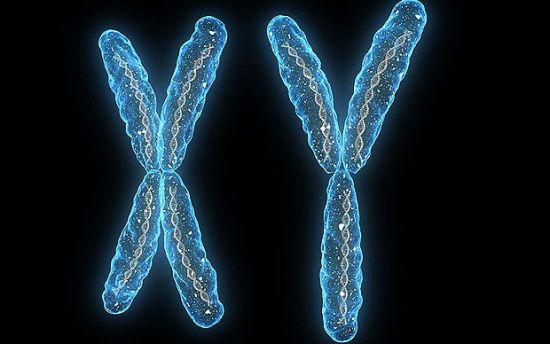导读:近年来,一些科学家甚至认为Y染色体正呈萎缩之势,预计会在500万年内消失,而男性也会随之灭绝。不过,美国科学家的一项最新研究显示,上述观点实在是“危言耸听”,这个世界上还会一直存在男人的身影。

男性之所以为男性是由Y染色体决定的。然而男性虽然强悍,他们的Y染色体却是羸弱的。近年来,一些科学家甚至认为Y染色体正呈萎缩之势,预计会在500万年内消失,而男性也会随之灭绝。不过,美国科学家的一项最新研究显示,上述观点实在是“危言耸听”,这个世界上还会一直存在男人的身影。
染色体是基因的载体。人类的细胞中有23对染色体,其中包括22对常染色体和1对性染色体。性染色体包括X和Y染色体,决定人类的性别。男性的性染色体为XY,而女性为XX。
与“勤劳强大”的X染色体相比,男性特有的Y染色体显得“懒惰矮小”。它不但体积不及X染色体的1/3,而且其中绝大多数DNA序列都是没有功能的,参与“工作”的基因甚至不及X染色体的1/10。
但是,Y染色体也有自己的核心竞争力,它的存在对人类性别的决定具有重要意义,其王牌就是SRY基因。SRY基因,又称睾丸决定因子,在胚胎的性分化过程中,SRY基因刺激男性胚胎完全向男性化的方向发展。可以这样说,没有SRY基因,世界上就没有男人。
几年前,在一次名为“Y染色体的衰退和消亡以及男性未来”的讲座中,澳大利亚国立大学基因研究专家珍妮弗·格雷夫斯指出:“3亿年前每个Y染色体上大约有1400个基因,而现在只剩下45个。按照这种衰减速度,500万年后Y染色体上就不再有任何基因了。Y染色体正在消亡,男性群体可能最终灭绝。”
格雷夫斯的观点经媒体报道后,在社会上引起极大反响。为了确定“Y染色体消亡说”是否存在夸大事实的嫌疑,最近美国怀海德生物医学研究所研究人员珍妮弗·休斯等人在比较了人和恒河猴的Y染色体上的基因后发现,人类Y染色体上基因衰减的速度正逐渐降低,几乎进入停滞状态。
人和恒河猴曾经拥有共同的祖先,在他们走上各自进化道路的2500万年里,虽然人类Y染色体的长度远远超过恒河猴,但是他们Y染色体的基因构成基本一致。
休斯说,与恒河猴Y染色体相比,人类Y染色体2500万年来只流失了一个基因,而在过去600万年里,人类Y染色体上的基因流失数为零,其基因衰减的速度越来越慢。“所以,我相信即使再过5000万年,人类Y染色体依然会存在,‘Y染色体消亡说’可以就此打住了。”

Strict evolutionary conservation followed rapid gene loss on human and rhesus Y chromosomes
Jennifer F. Hughes, Helen Skaletsky, Laura G. Brown, Tatyana Pyntikova, Tina Graves, Robert S. Fulton, Shannon Dugan, Yan Ding, Christian J. Buhay, Colin Kremitzki, Qiaoyan Wang, Hua Shen, Michael Holder, Donna Villasana, Lynne V. Nazareth, Andrew Cree, Laura Courtney, Joelle Veizer, Holland Kotkiewicz, Ting-Jan Cho, Natalia Koutseva, Steve Rozen, Donna M. Muzny, Wesley C. Warren, Richard A. Gibbs
The human X and Y chromosomes evolved from an ordinary pair of autosomes during the past 200–300 million years. The human MSY (male-specific region of Y chromosome) retains only three percent of the ancestral autosomes’ genes owing to genetic decay. This evolutionary decay was driven by a series of five ‘stratification’ events. Each event suppressed X–Y crossing over within a chromosome segment or ‘stratum’, incorporated that segment into the MSY and subjected its genes to the erosive forces that attend the absence of crossing over. The last of these events occurred 30 million years ago, 5 million years before the human and Old World monkey lineages diverged. Although speculation abounds regarding ongoing decay and looming extinction of the human Y chromosomeremarkably little is known about how many MSY genes were lost in the human lineage in the 25 million years that have followed its separation from the Old World monkey lineage. To investigate this question, we sequenced the MSY of the rhesus macaque, an Old World monkey, and compared it to the human MSY. We discovered that during the last 25 million years MSY gene loss in the human lineage was limited to the youngest stratum (stratum 5), which comprises three percent of the human MSY. In the older strata, which collectively comprise the bulk of the human MSY, gene loss evidently ceased more than 25 million years ago. Likewise, the rhesus MSY has not lost any older genes (from strata 1–4) during the past 25 million years, despite its major structural differences to the human MSY. The rhesus MSY is simpler, with few amplified gene families or palindromes that might enable intrachromosomal recombination and repair. We present an empirical reconstruction of human MSY evolution in which each stratum transitioned from rapid, exponential loss of ancestral genes to strict conservation through purifying selection.
文献链接:https://www.nature.com/nature/journal/vaop/ncurrent/full/nature10843.html








